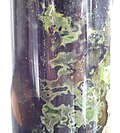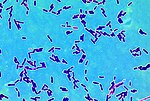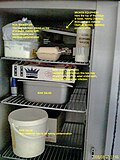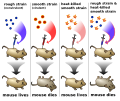Bacteria
Search results for
There is a page named "Bacteria" on Wiki Simple English. See also the other search results found.
 Bacteria (singular: bacterium) are very small organisms. They are prokaryotic microorganisms. Bacterial cells do not have a nucleus, and most have no organelles...
Bacteria (singular: bacterium) are very small organisms. They are prokaryotic microorganisms. Bacterial cells do not have a nucleus, and most have no organelles... The green sulfur bacteria are a phylum of obligately anaerobic photoautotrophic bacteria. They metabolize (~eat) sulfur. They are put in their own phylum...
The green sulfur bacteria are a phylum of obligately anaerobic photoautotrophic bacteria. They metabolize (~eat) sulfur. They are put in their own phylum... Gram-negative (redirect from Gram-negative bacteria)Gram-negative bacteria are bacteria that do not retain crystal violet dye in staining. In a Gram stain test, a counterstain, safranin, is added after...
Gram-negative (redirect from Gram-negative bacteria)Gram-negative bacteria are bacteria that do not retain crystal violet dye in staining. In a Gram stain test, a counterstain, safranin, is added after...- Purple bacteria are bacteria that are phototrophic, meaning that they are able to make energy from light. They change the energy from the Sun into chemical...
 Lactic acid bacteria are bacteria which make lactic acid. This is an end product of carbohydrate fermentation. The bacteria change carbohydrates to lactic...
Lactic acid bacteria are bacteria which make lactic acid. This is an end product of carbohydrate fermentation. The bacteria change carbohydrates to lactic... Gut flora (redirect from Gut bacteria)microorganisms in the intestines. The metabolic activities performed by these bacteria resemble those of an organ, leading some to call gut flora a 'forgotten...
Gut flora (redirect from Gut bacteria)microorganisms in the intestines. The metabolic activities performed by these bacteria resemble those of an organ, leading some to call gut flora a 'forgotten...- chemical compound that kills bacteria or slows their growth. They are used as medicine to treat and cure diseases caused by bacteria. The first antibiotic discovered...
- Sand filter (redirect from Bacteria bed)A sand filter is a layer of sand which is used to clean water of bacteria and other microorganisms. It is a type of filter. A layer of sand or gravel is...
 Gram-positive (category Gram-positive bacteria)Gram-positive bacteria are those that are stained dark blue or violet by Gram staining. This is in contrast to gram-negative bacteria, which cannot hold...
Gram-positive (category Gram-positive bacteria)Gram-positive bacteria are those that are stained dark blue or violet by Gram staining. This is in contrast to gram-negative bacteria, which cannot hold... Proteobacteria (category Gram-negative bacteria)The Proteobacteria are a major phylum of bacteria. They are gram-negative bacteria. This means they do not retain the violet dye in the Gram staining...
Proteobacteria (category Gram-negative bacteria)The Proteobacteria are a major phylum of bacteria. They are gram-negative bacteria. This means they do not retain the violet dye in the Gram staining... Gammaproteobacteria (category Gram-negative bacteria)group of bacteria. They include important bacteria, such as Pseudomonas aeruginosa and Fransicella tuarensis. They are gram-negative bacteria. This short...
Gammaproteobacteria (category Gram-negative bacteria)group of bacteria. They include important bacteria, such as Pseudomonas aeruginosa and Fransicella tuarensis. They are gram-negative bacteria. This short... Food poisoning (redirect from Food poisoning bacteria)agent or by infectious agent. Food infection is when the food contains bacteria or other microbes which infect the body after it is eaten. Food intoxication...
Food poisoning (redirect from Food poisoning bacteria)agent or by infectious agent. Food infection is when the food contains bacteria or other microbes which infect the body after it is eaten. Food intoxication... Griffith's experiment (category Bacteria)experiments showing that bacteria can get DNA through a process. Griffith used two strains of Streptococcus pneumoniae. He then uses the bacteria to infect the mice...
Griffith's experiment (category Bacteria)experiments showing that bacteria can get DNA through a process. Griffith used two strains of Streptococcus pneumoniae. He then uses the bacteria to infect the mice... Salmonella (category Gram-negative bacteria)Salmonella is a genus of bacteria. It is a major cause of illness throughout the world. The bacteria are generally passed on to humans by eating or drinking...
Salmonella (category Gram-negative bacteria)Salmonella is a genus of bacteria. It is a major cause of illness throughout the world. The bacteria are generally passed on to humans by eating or drinking... Halomonadaceae (redirect from Arsenic bacteria)discovering new facts about them. GFAJ-1 is a strain of rod-shaped extremophile bacteria in the Halomonadaceae. It was claimed that, when it did not have phosphorus...
Halomonadaceae (redirect from Arsenic bacteria)discovering new facts about them. GFAJ-1 is a strain of rod-shaped extremophile bacteria in the Halomonadaceae. It was claimed that, when it did not have phosphorus... Bacillales (category Gram-positive bacteria)The Bacillales are an order of Gram-positive bacteria. Many bacteria of this order make endospores. The order include the following families: Alicyclobacillaceae...
Bacillales (category Gram-positive bacteria)The Bacillales are an order of Gram-positive bacteria. Many bacteria of this order make endospores. The order include the following families: Alicyclobacillaceae... Typhus (category Diseases caused by bacteria)Typhus is the name for a number of diseases, caused by bacteria called Rickettsiae. These bacteria are parasites that cannot survive outside their host...
Typhus (category Diseases caused by bacteria)Typhus is the name for a number of diseases, caused by bacteria called Rickettsiae. These bacteria are parasites that cannot survive outside their host... Enterobacteriaceae (category Gram-negative bacteria)family of bacteria commonly affecting the stomach. The name is derived from the prefix "entero-", meaning intestine; "bacteria", meaning bacteria; and "ceae"...
Enterobacteriaceae (category Gram-negative bacteria)family of bacteria commonly affecting the stomach. The name is derived from the prefix "entero-", meaning intestine; "bacteria", meaning bacteria; and "ceae"...- Bacteriology (category Bacteria)is the study of bacteria. Bacteriologists study, identify, classify, and describe bacterial species. Microorganisms such as bacteria, protozoa, fungi...
 Streptococcus (category Gram-positive bacteria)is a genus of spherical Gram-positive bacteria belonging to the phylum Firmicutes and the lactic acid bacteria group. They are cocci, meaning that they...
Streptococcus (category Gram-positive bacteria)is a genus of spherical Gram-positive bacteria belonging to the phylum Firmicutes and the lactic acid bacteria group. They are cocci, meaning that they...
- Singular bacterium Plural bacteria














